EULAR Sjögren's Syndrome Disease Activity Index (ESSDAI ...
EULAR Sjögren's Syndrome Disease Activity Index (ESSDAI ...
EULAR Sjögren's Syndrome Disease Activity Index (ESSDAI ...
You also want an ePaper? Increase the reach of your titles
YUMPU automatically turns print PDFs into web optimized ePapers that Google loves.
inserm-00431527, version 1 - 12 Nov 2009<br />
METHODS<br />
This paper results from a collaboration of experts identified through their involvement in the<br />
primary SS field, headed by a steering committee of 7 physician experts in SS (HB, SB, JEG,<br />
XM, ET, AT, CV), a clinical epidemiologist (PR) and a rheumatologist, a fellow in clinical<br />
epidemiology (RS). The research protocol was endorsed by <strong>EULAR</strong> (project code CLI 010).<br />
The steps of the development of the <strong>ESSDAI</strong> are summarized below; the entire methodology<br />
is available online (Appendix 1).<br />
Selection of relevant domains and definition of items<br />
Domains of organ-specific involvement relevant to assess disease activity were selected in<br />
these steps. For each domain, the different clinical manifestations were ranked by level of<br />
activity (i.e., items). For selection of domains relevant to disease activity and definition of<br />
items for each domain, steering committee members prepared a preliminary proposal on the<br />
basis of their clinical experience, literature review and previous work.[16, 17] The<br />
preliminary selection of domains and items were successively submitted to the expert panel.<br />
Experts had to rate the importance of each domain or suggest any additional domains or<br />
changes to proposed items. Intention-to-treat was used as a help for experts to define the<br />
different activity levels that ranged from no activity (requiring no treatment) to high activity<br />
(requiring high dose steroids or immunosuppressant). The experts’ proposals were analyzed,<br />
then discussed and voted on during a meeting.<br />
Elaboration of clinical vignettes<br />
In this step, realistic clinical vignettes were generated from real patient profiles.<br />
Abstraction and standardization of real patient profiles<br />
Five members of the steering committee supplied 96 profiles of their patients with systemic<br />
complications of primary SS. Each profile had to contain sections on “History” (demographic<br />
data and past medical history), “Today” (clinical symptoms and results of imaging<br />
examination) and “Laboratory” (biological features). Patient profiles included data from the<br />
baseline and 2 follow-up visits (3 and 6 months).<br />
Abstraction of descriptions of items from real patient profiles<br />
From patient profiles, 96 histories and 364 items, included in the “Today” and “Laboratory”<br />
sections, were extracted and standardized by the same investigator (RS). Description of all<br />
<strong>ESSDAI</strong> items were obtained and entered in a database with their corresponding scoring<br />
(domain and activity level). Each item had a median of 8.5 (interquartile range [IQR: 4-15]<br />
descriptions.<br />
Generation of realistic clinical vignettes<br />
(i) Determination of construction rules<br />
Data from primary SS patient cohorts of 5 members of the steering committee (SB, XM, ET,<br />
AT, CV)[16-20] were used to construct a sample of vignettes with characteristics similar to<br />
European patient cohorts.<br />
(ii) Generation of clinical vignettes<br />
In total, 720 clinical vignettes were generated by a combination of “History” and items from<br />
the “Today” and “Laboratory” sections, with respect to the domain and item distribution<br />
defined previously. However, because items in the database referred to only systemic features,<br />
descriptors of symptoms such as dryness, pain and fatigue were generated and assigned to<br />
30% of the patient vignettes.<br />
Assessment<br />
5




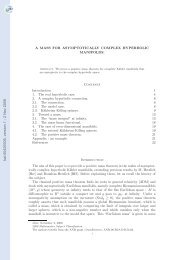

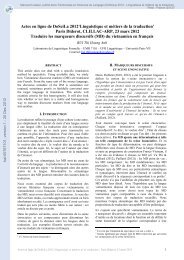
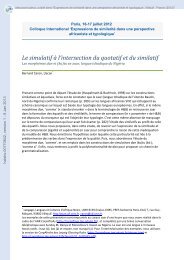
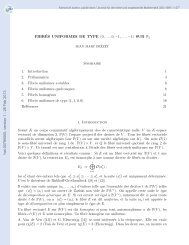
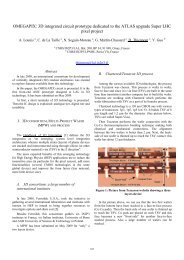
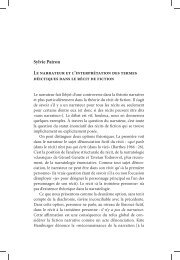
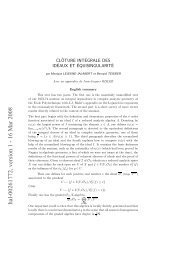
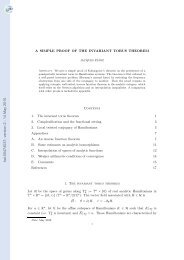

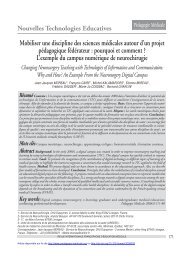

![[tel-00433556, v1] Relation entre Stress Oxydant et Homéostasie ...](https://img.yumpu.com/19233319/1/184x260/tel-00433556-v1-relation-entre-stress-oxydant-et-homeostasie-.jpg?quality=85)